Link building is a pillar of any SEO strategy. It’s based on constructing a network of links across your pages to demonstrate your authority in a given field to Google.
Have you ever thought about just how much value search engines give to what links say? Through links, web crawlers discover new content to index and understand how pages relate to one another.
These relationships reveal a web page’s true relevance, which is essential to a high position in search results.
This is why it’s not enough to simply create a website with a responsive design, improve its page speed, and create relevant content.
It’s time to look at link building and construct a powerful network of links to your website.
Do you want to learn more about putting link building into practice and achieving the best results with your Digital Marketing strategy? Follow our article to know:
What is Link Building?
Link building is a set of SEO strategies that aim to build a network of links to a page to drive traffic and strengthen its authority in search engines.
Links can be either external or internal. In link building terms, the external ones come from other sites, also referred to as backlinks or inbound links.
These links show Google a site’s popularity and authority in the market. The search engine investigates the links leading to the site to see how often it’s cited and the quality of those references.
The more links received from trustworthy and popular sites, the more relevant Google considers the site in its area of expertise.
The algorithm’s intelligence also considers the anchor text, the content around the link, its page position, and other factors that we will take a deeper look at below.
All of these elements impact the indexing and ranking of the linked page.
But link building also includes internal links, those included on the site’s pages. They may target pages on or off the site.
Google also evaluates these links to understand the quality and relevance of a page and, consequently, whether it merits a better ranking in search results.
But, like any decision in the world of SEO, you must first consider the user before worrying about the robot.
For this reason, links are primarily a way to improve the user experience by allowing them to discover additional content while browsing a page.
So, instead of pushing link building artificially, only add links when they make sense to the user. This is how you will gain traffic and authority through this strategy.
Difference between link building and off-page SEO
Although the term off-page SEO is often used interchangeably with link building, their concepts are different:
- Off-page SEO refers to all search engine optimization strategies that are applied beyond a site’s pages.
- Link building involves building a network of links to strengthen pages’ authority.
Off-page SEO encompasses backlinks received from other sites, part of a link building strategy. But it also includes brand mentions without links, an additional ranking factor for Google.
Therefore, link building is only one part of off-page SEO.
In a link building strategy, it’s important to know that you can’t just look beyond your site.
Building a network of links to show Google your relevance involves receiving external links (part of off-page SEO) and adding links on your pages (part of on-page SEO).
So when planning your link building strategy, you need to look at both on-page and off-page SEO.
Keep in mind that one characteristic of on-page SEO is that it’s under your control — you can edit your pages and optimize your internal links to best suit your objectives.
As for off-page SEO, you may be able to influence it, but the decision to link to and mention your site is not directly within your control.
Why are Links Important?
The World Wide Web can be defined as a set of interconnected documents that form a web. Links are responsible for these connections, allowing users to navigate between pages, sites, images, videos, and files.
Search engines rely on this link structure to crawl and rank websites.
In the beginning, search engines were limited to indexing and organizing sites in alphabetical order or directories (arts, sports, news, etc.). Sites had to register to appear in these indexes.
Back when there were relatively few sites, this process was ok. But as the volume of users, websites, content, and searches increased dramatically, search engines needed to improve their algorithms to deliver better search results.
First, search engines removed the need for sites to register. Search providers started to look for sites to include in their indexes. So began the mission to catalog all web pages and make the content available to users in an organized fashion.
To accomplish this task, search engines took advantage of the interconnected structure of the web.
It continues to work this way nowadays: links reveal the web paths for search engine robots, which crawl websites to index new content or updates.
After that, there was no longer any point in ordering sites alphabetically. It was necessary to analyze what pages were offered and whether they had the answers users were looking for.
At this point in the story, Google came to the forefront. The most popular search engine in the world today began its journey with the introduction of an algorithm that revolutionized search: PageRank.
PageRank considered several factors to rank sites in the search index. The algorithm analyzed the page’s content, based on its keywords and its popularity on the internet, measured through its network of links.
The objective was to measure the site’s relevance according to the number of links it received from other sites.
This employed the same logic as in academia: the more citations an author receives, the more authority they have in a given field. So, the more links a site receives, the more relevant it is in its area of expertise.
As a result, links demonstrate the authority of a website. This is also how they became important for search engines and SEO professionals.
Since the introduction of PageRank, Google’s algorithm has continued to evolve.
They soon realized that the number of links was not enough to measure a site’s relevance because it could simply create hundreds of links.
Thus, Google began to consider the diversity and quality of the pages that pointed to backlinks.
The algorithm defined that when high-quality pages from different domains create links, the page they link to receives part of their authority, commonly referred to as link juice.
Thus, the search engine can classify the sites according to their level of authority in the market.
At this point, a site’s reliability (TrustRank), anchor texts, the position of backlinks on the page, and several other factors which we explore below came into play.
A page that links to another shows the web crawler a path to take and the URLs it is sharing its authority with. Therefore, links are essential for crawling and ranking websites on search engines.
How Does Google Evaluate Links?
Google’s algorithm uses a multitude of factors to rank pages, which include link evaluation.
We’ll take a look now at the main factors that Google evaluates in a page’s links profile. This evaluation goes far beyond quantity, also considering the quality, based on various criteria.
Here are the factors you should consider in your link building strategy.
1. Number of links
This was the first factor Google adopted. It formed the basis of PageRank: the more links a site received, the more relevant it was considered. The number of links to a page demonstrated its popularity on the web.
Today, this criterion remains one of the most important factors in evaluating Google links, but it cannot be considered in isolation.
There’s no point in receiving numerous links from sites that are not relevant and reliable. It is necessary to match quantity with the factors that we will see below.
2. Diversity of links
Which has more value: an individual who always says how great you are, or several people who each say once how great you are?
The more people who speak well of you, the more recognition you have in a group.
Google thinks along the same lines. For the search engine, a site reveals stronger authority when it receives links from several different domains. Therefore, link diversity is also included in the evaluation.
3. Link context
Google can also understand the context around the link to gauge if it’s truly relevant.
For starters, Google understands that links from sites that relate to the same field as the target site are more valuable since they are more likely to be relevant to the site’s audience.
Google also evaluates the words that appear around the link, known as co-occurrences. They help the search engine understand the page’s topic and whether the link makes sense within the context.
In addition to the words, Google also evaluates other links that are nearby. If they are also links to quality sites, the page gains more relevance and transmits more link juice.
But if you already have a large number of links, your page tends to receive less link juice, as the site is already transmitting its authority to many other pages.
Besides, the position of links also counts. If it’s part of the main content on the page, there’s a great chance of being inserted with editorial intention, achieving greater value as a result, especially at the beginning of a text.
But, when found in the header or footer, it’s more likely to serve the role of simply generating a backlink and is therefore valued less.
4. Anchor text
The anchor text — the clickable text of the link — also says a lot about the linked page.
It usually provides a keyword or short description of what the user will find on the page when clicking on the link. Therefore, Google uses this factor to index pages.
Also, analyzing the anchor text helps to identify sites trying to deceive the search engine.
Using an exact keyword match in a backlink anchor text is one way to reinforce the authority for that term.
However, when used repeatedly in all backlinks, Google will see this unnatural use as employing black hat techniques. When backlinks are naturally earned, anchor texts tend to be diverse.
5. Reliability
An evolution in Google’s algorithm was TrustRank. When this factor was added to the algorithm, the search engine began to weigh the site’s reliability in its ranking.
So, the closer you are to trusted sites, the more trustworthy you appear to Google, and the more link juice you will receive.
Trusted sites are those that help to build a safer and more relevant web for the user.
To assess reliability, the search algorithm considers factors such as the domain’s age, the use of security certificates, and the quality of content, among other elements.
6. Links from other pages to your website
In link building, you can work with internal and external links. But it’s important to know which one carries more weight in the ranking.
To understand this, consider the following: does Google trust a site based more on what it has to say about itself (internal links) or what other sites say about it (external links)?
What others say is more valuable, so backlinks from other pages tend to weigh more in the search evaluation.
7. Links from your site to its pages
The links you insert into your site are not as valuable backlinks, but they do help show your page hierarchy to Google.
Let’s say you have a promotional marketing company featuring an in-depth blog post that explains what promotional marketing is.
As this publication is central to your business, additional shorter posts can direct links to it, so that Google understands this main post should be at the top of the blog hierarchy.
8. Links from your site to other pages
Besides, links within your pages that lead to external sites also weigh in the ranking.
Google assesses whether you provide links to popular, trusted, and authoritative sites, along the lines of “tell me who you are with and I’ll tell you who you are”.
9. Link gain speed
In the early days of SEO, backlinks were a key tool of black hat techniques — practices used to deceive search engines.
Many websites created link farms or used link buying and selling schemes. Thus, they quickly gained backlinks.
To counter this, Google reinforced its algorithm to identify and penalize this practice. One resource to measure this is how fast your site earns links.
Earning many links in a short period usually indicates a black hat scheme, as a natural link profile has gradual growth.
10. Nofollow vs. dofollow
Another factor that Google evaluates when analyzing links on a page is the nofollow attribute.
When it’s placed in the link code, the web crawler knows not to consider the ranking of the linked page.
This means that nofollow links do not transmit link juice.
By default, all links are do-follow or transmit link juice. When you don’t want to transmit authority through a link, you must insert the nofollow tag.
If you need to cite a dubious website, for example, you can use the nofollow tag to not share your authority with it.
This tag is also commonly used in social media links or blog comment boxes.
Facebook, Instagram, or blog owners want to avoid transmitting their authority to links that any user may insert on a page, mainly because these spaces are often used for spam.
What are the Main Link Building Techniques?
To put link building techniques into practice, it’s important to keep Google’s link evaluation factors in mind.
This will allow you to build a strong network of links to your pages regarding both quantity and quality.
So here are the main practices we recommend!
1. Create digital marketing assets
Content Marketing is a central pillar of link building. Before thinking about chasing links, you need to ensure that users will like what they find on your site.
By doing so, you will achieve results through the visitors you receive, in addition to getting your content shared by them — thus generating more links to your site.
To increase the chance of sharing, invest in creating linkable Digital Marketing assets. Here, we’re talking about creating content that has high sharing potential.
This means content so good, so relevant to the public, that it spreads out independently, without you having to struggle to generate links.
Here are a few examples to get started with:
- infographics
- interactive content, such as quizzes, calculators, and assessments
- posts with lists
- complete guides
- research results you’ve found
These are just a few examples of linkable assets that you can produce. They stand out because they are easy to understand (like visual content), engaging (like interactive content), or bring new and original data (like research).
Regardless of the format, don’t forget that quality content is the number one rule.
2. Search for backlink partners
Receiving backlinks is an aspect of off-page SEO and is not entirely under your control: links to your pages come from third parties.
But the decision can be made easier when you have good relationships with other sites, leading them to be more willing to link to your content.
The main concern when starting a link building strategy is: how to find the best partners to generate backlinks?
The best partners are sites that are trusted by Google, and authorities in their field that produce good content related to their area of expertise.
Generally, these sites are already well-positioned for their main keywords — and you can use the tools below to find out what they are.
One way to identify the best partners is through the Domain Authority (DA) and Page Authority (PA) indicators of Link Explorer, Moz’s tool.
These indicators simulate how Google’s algorithm views search results based on several ranking factors that the search engine uses to create an authority score for pages and websites.
This score ranges from 0 to 100 and reveals the page or domain’s chances to reach the SERP’s top position. The higher the score, the better.
There, you can check the DA and PA scores of potential partners to see if it’s worth getting backlinks from them. To do so, you can use Link Explorer for free (with some limitations).
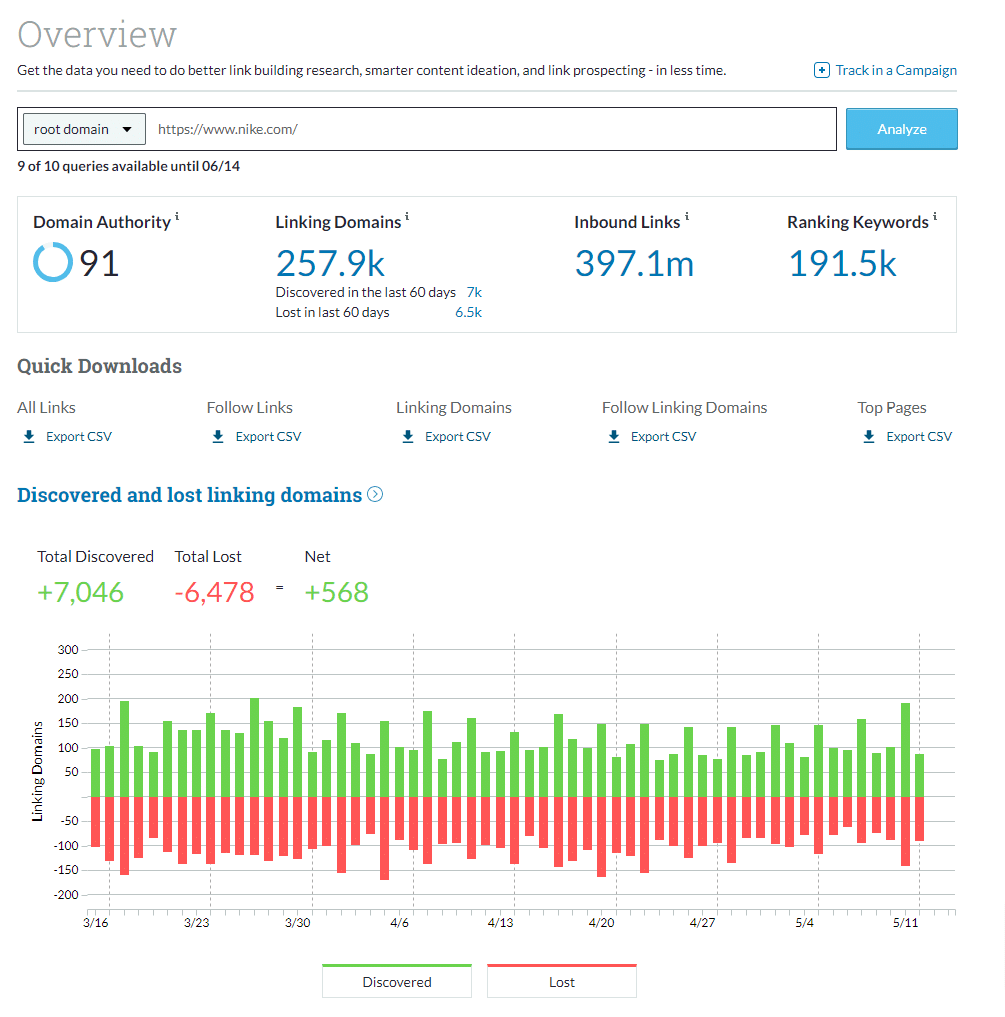
You can also use the Link Explorer extension for Chrome or Firefox, called MozBar. Any keyword you search for, presents the main indicators of the tool in SERP.
As a result, you can evaluate potential partners directly in the search results. See an example below in a search for the keyword “Digital Marketing Tools”:

When you find interesting partners, try to start with a friendly, low-key approach.
Start slowly, offering to help with a problem or content, displaying your interest in contributing, and building a relationship of trust. It may take longer, but it is more likely to consolidate a partnership.
3. Guest posting and co-marketing
Once you find and approach your ideal partners, you can suggest methods to generate backlinks.
The most common link building techniques with partners are guest posting and co-marketing.
Guest posting consists of creating content as a guest author on a blog. You produce a post that is relevant to your partner’s blog, and in return, they allow you to insert one or more links to your pages.
Thus, your partner transmits part of their authority to you, and your website attracts more visitors.
Guest posts have been greatly discredited in recent years as the practice has become popular and lost its original purpose.
Many partnerships were created just to generate backlinks without thinking about the user experience. Of course, this didn’t work. The strategy only works when it is relevant to visitors.
Another strategy is co-marketing, which refers to the practice of companies coming together to create materials in partnership, such as ebooks or tools. So, both partners promote the product and link to each other’s pages.
The same rule applies here: create material that is truly relevant to the audience!
For both strategies, it is important to choose partners that have a similar audience to yours, so that you attract visitors who will be interested in your content.
4. Invest in press relations
Links on news portals and press sites are valuable. These sites are generally recognized by Google and have great authority on the web.
For example, see how high the Domain Authority of sites such as The Guardian and The New York Times are (both at 100):
Besides, these sites also reach many regular readers, leading to massive spontaneous sharing for any subject appearing there. Wouldn’t it be great to receive a link or at least a mention from these sites?
A press office strategy can help you achieve this. An advisor handles the work of building a relationship and communicating with media outlets.
They pass along information and achievements about clients that are valuable for a news item, report, or interview. Thus, you get a space in the press, without having to pay for it.
Currently, the press office can also include digital channels, social networks, and influencers in its reach, not just large traditional organizations. So you are more likely to find a space, attract visitors, and earn links.
5. Find mentions without a link
Did you know that mentions without a link can also bring ranking value? Google notices when brands are being widely cited on the web and gaining popularity.
The search engine then associates the mentions with the brand’s site and uses this factor when ranking.
However, mentions do not convey authority from one site to another. Only links do that. A mention is good, but a mention with a link is better!
So what you can do is follow up on mentions your brand has already received and contact the site administrator to include a link. With a friendly approach, you have a good chance of getting that link.
To find these mentions, you can use Google Alerts, which issues a notification whenever your brand (or any terms you define) is mentioned.
Another way to do this is to simply use Google search. Just search for your brand to find sites that mention it. But here is a small tip: remove your website from the search results.
You can do this by using the exclude search attribute: “rock content” -site: rockcontent.com. The results show sites — not including ours — that have already mentioned Rock Content.
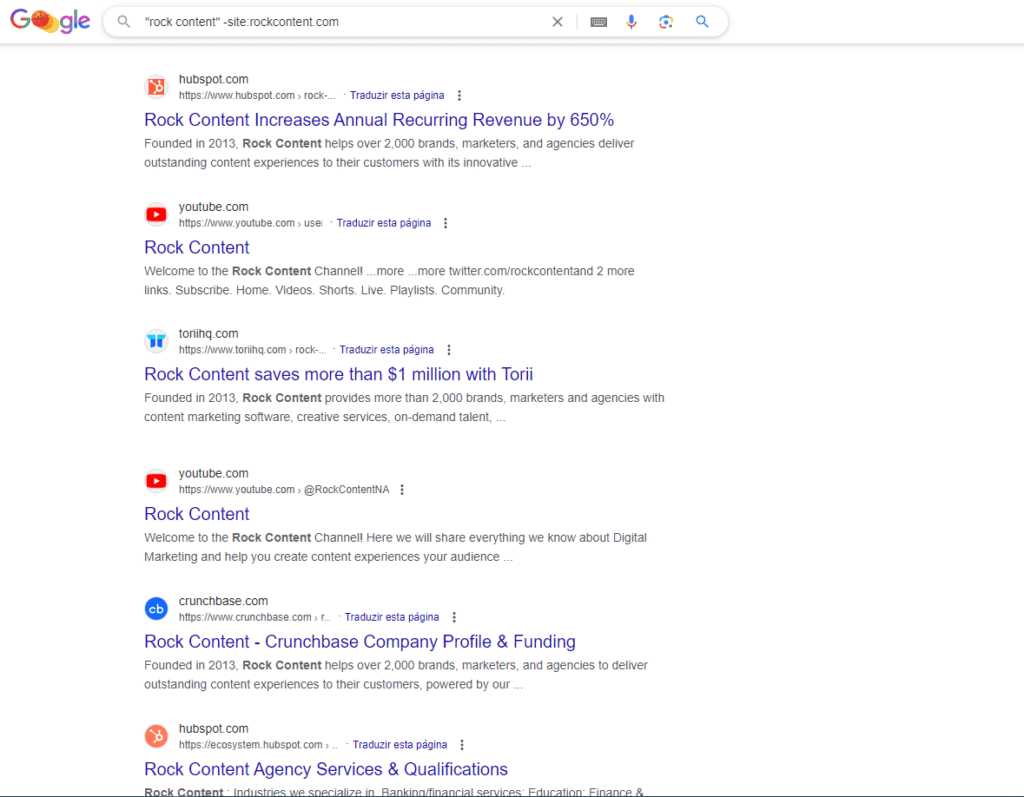
6. Use topic clusters for internal links
Topic clusters are a strategy for creating a hierarchy for a site or blog page through a network of internal links.
It works like this: you create a post based on a keyword essential to your business. This will be the central content for the topic cluster.
For example, in the case of Rock Content, we can say that a post on Content Marketing is a pillar content.
Then, other posts with more specific keywords link to that main content. Preferably, this link should be the first in the text.
In Rock Content, posts on SEO, email marketing, and social media do this, with links to the post on Content Marketing.
Thus, these satellite posts strengthen the authority of the pillar content, which is at the top of the site’s hierarchy. Google understands this and values the main content in the ranking.
7. Redirect broken links
It is natural for links to no longer form part of a site. Content gets updated or deleted, or sites change their URL structure, generating broken links.
When the user tries to access these links, they encounter a 404 error, informing them that the page cannot be found.
When this happens, it not only frustrates the user and costs you traffic, but you also lose the link juice the link would transmit to your page. How to fix this problem?
To do so, you need to redirect broken links to the correct URLs. We’re talking about 301 redirects, which consist of a change to the page’s code to redirect users to the page they want to access.
A tool like Screaming Frog can help you with this task. It is very effective at finding broken links on your site and then auditing the redirects you make.
To create redirects, you may need a developer’s help, as you need to tinker with the code. But if you have a WordPress site, plugins like SEO Redirect make it easy.
If the page doesn’t exist anymore (for example, if the content was deleted), you can create a custom 404 error page.
Inform the user that the content no longer exists, but offer alternative content that they may enjoy.
8. Reject dubious backlinks
Not all backlinks you receive are good. Often, sites receive links from spam or questionable sites, which can negatively impact their ranking. Remember that you need to have trusted neighbors to earn Google’s trust.
An important link building strategy is to reject dubious or unwanted backlinks.
A great tool for this is Google Search Console. It has a specific feature to reject backlinks. You only need to let it know which pages or domains should be rejected.
Although it may take a while, Google will soon stop considering these sites in its ranking.
In addition to this tool, you can also try to speak directly to the site administrator to remove the backlink.
9. Learn from your competitors
A hugely important part of good digital marketing is keeping track of what your competitors are doing, and this includes in regards to link building.
So definitely check out what other brands in your industry are up to, especially if they rank higher than you do for your target keywords.
You can use a free tool like Ubersuggest or Backlink Gap Tool to get a read on where their backlinks are coming from.
Just run an analysis on your competitor’s domain, check the list of sites linking back to them, and scan it for clues about their go-to strategy.
Maybe they’re doing a lot of guest blogging. Or perhaps they’ve got lots of links from big corporate sites and key publications that are likely the result of deep networking.
Whatever they’re doing, think about how you can do something similar yourself to get ahead.
10. Earn links via great content
Ultimately, there’s no trick or strategy that can trump the power of terrific content.
Great content supports your link building strategy by earning quality links for you. So focus on creating high-value posts that people can’t help but mention and share with their own followings.
Posts with value aim to answer questions members of your audience may have but might not think to ask. They help people make decisions, deep-dive into key industry trends, and address popular topics from fresh, exciting, new angles.
They also innovate by leveraging multimedia and interactivity, as well.
But people can’t share and link back to things they can’t find, so make sure you’re actively promoting your best content and helping it make the rounds.
Post at opportune times, make the most of social media, and so forth.
11. Create valuable link roundups
Link building and networking go hand in hand, so listing posts that showcase other people’s awesome content is an excellent way to give you a boost in both areas.
Other brands and content creators in your industry and chosen niche watch their backlinks just as carefully as you do, so they’ll notice that you’ve included them.
They’ll also be flattered to be included, especially in top lists or roundups meant to shine a spotlight on must-read pieces. Some will likely feel inspired to return the favor at some point, helping you to build your backlink catalog and build positive relationships with peers.
Plus, roundups make incredible content that’s truly valuable to your readers.
Get ideas for sites to include by seeing what comes up when you Google a target keyword or by checking out what others in your niche are linking to.
12. Conduct original research
As every content creator and marketer already knows, thorough research that provides value to an audience is priceless.
However, someone naturally has to conduct that research in the first place. Why shouldn’t that person be you?
High-quality original research on crucial industry concepts your peers need to know is an incredible way to establish yourself as an authority. And writing organized, readable reports on your findings can send your link building strategy through the roof.
You can certainly do your own research. But if you don’t feel equipped to do it yourself (or otherwise would rather not), you can hire a research team to do the heavy lifting for you.
Then use the findings to create memorable, helpful blog posts, infographics, videos, and more.
13. Focus on earning editorial links
Although there’s nothing wrong with requesting the occasional link from a peer, sponsoring influencers, or otherwise encouraging content creators to help you with your link building strategy, you also want to focus on earning editorial links.
Editorial links are links that are entirely organic, meaning they haven’t been requested, paid for, or traded for.
They are by far the most valuable links a brand can have, and there’s only one way to get them — by consistently producing incredible content.
Earn editorial links by blogging with purpose. Create high-value posts that help people solve problems, reach goals, and get better at things they want to master.
Support your advice and information with solid research and data from respected sources.
How to Build Links with Email Outreach
Although no brand should be relying entirely on requested backlinks, they’re a great way to round out a comprehensive strategy and should be part of everyone’s approach.
However, successful content creators receive far too many backlink requests to honor them all, so an intelligent approach to email outreach is crucial.
Target the right people
It’s not enough to simply target content creators and websites with large followings when it comes to link building.
Both they and their audience need to be perfect fits for your content. It’s also crucial that you explain how your content fits in your email.
Lead by showing proof that you understand and appreciate what they’re doing. Then follow up by clarifying how linking back to your content can benefit their audience and improve their content.
Get to the point
Editors and content creators with large followings are busy people.
They’re likely not going to read all the way through a lengthy email that takes forever to get to the point, so be as brief as you can.
Start with a gracious (but brief) introduction that includes any special connections you may have in common. Add some authentic praise for the person’s work or website. Then launch straight into your reason for emailing.
Put some thought into your subject line
Remember, you only have a few seconds to get a busy person’s attention, especially when they have an entire sea of emails to wade through every day.
A good subject line can make the difference between an email that gets an answer and one that goes straight to the trash folder without even being opened.
Like the body of your email, your subject line should get right to the heart of why you’re emailing. It should also be friendly, warm, and a bit personal. Avoid pushy or ad-like language at all costs.
How to Measure Link Building Success
Building a robust catalog of quality backlinks is ultimately a quality game, as opposed to a numbers game, so patience is key.
Be sure to track and analyze factors like the following to get an accurate read on the success of your efforts.
Referring Domains
Successful link building means playing the long game and playing it well, so it will take some time to start seeing results. But once you do, one of the places they’ll show up is in your traffic records.
A successful backlinking campaign will eventually show a gradual uptick in the number of referring domains pointing back to your site.
You can expect this trend to pick up speed as you continue to establish and build relationships with peers in your industry.
Google Search Rankings
Boosting your target page’s ranking on relevant Google SERPs is one of the most important goals of any link building campaign, if not the most important.
Given the best-case scenario, you want to see your star content pieces showing up within the top 3-5 search results.
So keep track of those search positions. Watch for evidence that your pages are rising in SERP results for your target keywords and search terms.
It’s a sign that your backlinking efforts (and overall SEO strategy) are doing what they were meant to do.
Organic Traffic
A solid link building strategy should also lead to an upward trend in high-value organic traffic, so make sure you’re keeping an eye on your overall traffic patterns and sources.
This can easily be done via Google Analytics, Google Search Console, and similar interfaces.
Again, it will take a while for a backlink strategy to yield fruit in this regard, especially if you occupy a competitive niche. But most brands will start seeing improvement within 3-12 months.
What are the Best Link Building Tools?
It’s difficult to develop a link building strategy without tools to help you identify partnership and linking opportunities, or recognize problems to correct.
Below, we present the main tools for these tasks.
1. Google Search Console
Google Search Console is one of the main tools for any SEO strategy, and it’s 100% free!
It communicates between a site and Google so the administrator can identify problems and optimization opportunities.
One of Google Search Console’s features for link building is rejecting backlinks, which we mentioned above.
Also, this tool alerts you if you have received any penalties due to black hat practices. This way, you can take steps to correct them.
2. Majestic
Majestic’s focus is on analyzing backlinks from other sites. It is arguably the most complete tool for this.
Unfortunately, it’s not free — subscriptions start at £39.99/month — but you can test some URLs before paying anything.
The tool performs a complete analysis of the backlinks profile of a page.
It includes proprietary indicators created by Majestic, such as Trust Flow and Citation Flow, which estimate a score for the quality and volume of citations on other sites, respectively.
You can also check information about anchor texts, backlinks context, nofollow links, and much more data.
3. Ahrefs
Ahrefs, a key SEO platform, is focused on off-page SEO. It’s also not free — you’ll need to purchase one of the plans, starting at $99/month.
Some features are extremely useful for link building:
- Site Explorer: allows you to search any web URL to learn about its backlinks profile. You can, for example, search for competitors and find out which sites link to them;
- Content Explorer: allows you to search for sites for a given keyword. It’s a solution to finding good link building partners;
- Alerts: issue a warning whenever a site gains or loses backlinks. This is great for monitoring competitors’ link building activities.
4. Link Explorer (Moz)
Moz, a reference in the SEO market, offers some free tools to help with optimization strategies. One of them is Link Explorer, which helps with link building strategies.
This tool analyzes any page you choose and reports on backlinks, competitors, broken links, anchor texts, and link building opportunities.
In the Pro version (starting at $99/month), you find complete data and analyses.
Also, Moz is responsible for the two indicators that we presented earlier: Domain Authority and Page Authority. So, to access them, you need to use this tool.
The reports that Link Explorer presents can also be accessed through MozBar, the free extension for Chrome, and Firefox. It shows this data directly on the SERP or when accessing sites.
5. Screaming Frog
Screaming Frog is an incredibly complete website audit tool for both on-page and off-page SEO. The free version has some limitations, but it’s a great first step, while paid plans start at £149/year.
For link building, the main features Screaming Frog offers include identifying broken links (404 errors) and auditing redirects. This is what you will need to recover link juice and not leave users lost on your site.
Wrap Up
Now you understand how link building works and have all the tips and tools to create your strategy.
Start evaluating the link profile on your pages today, make corrections and redirects, and look for partnerships and linking opportunities to improve your backlinks.
Show Google that you have authority on the web!
Master all of the SEO strategies you need to reach the top results on Google. Download our SEO Guide for free!
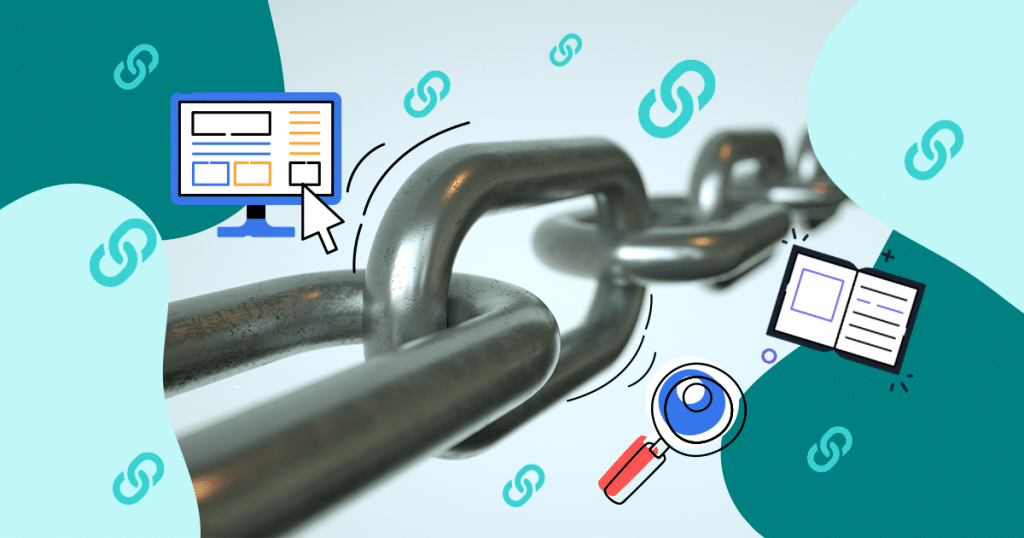

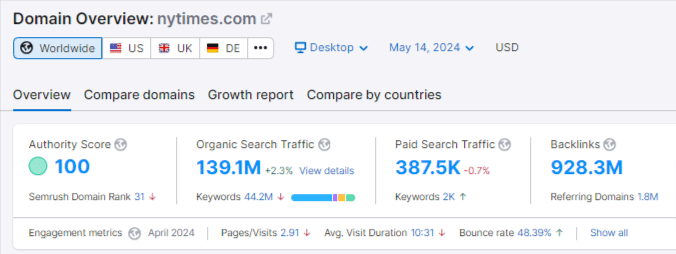
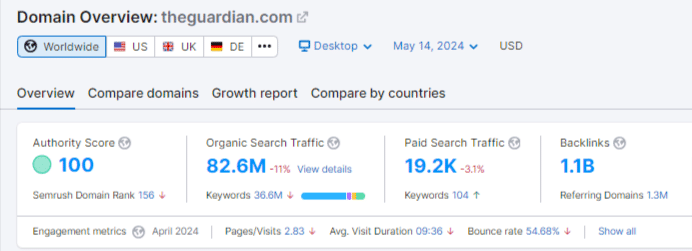


![[ROCK NA] [EBOOK SEO] Complete Guide](https://rockcontent.com/wp-content/uploads/2024/06/banner_Search-Engine-Optimization.png)






